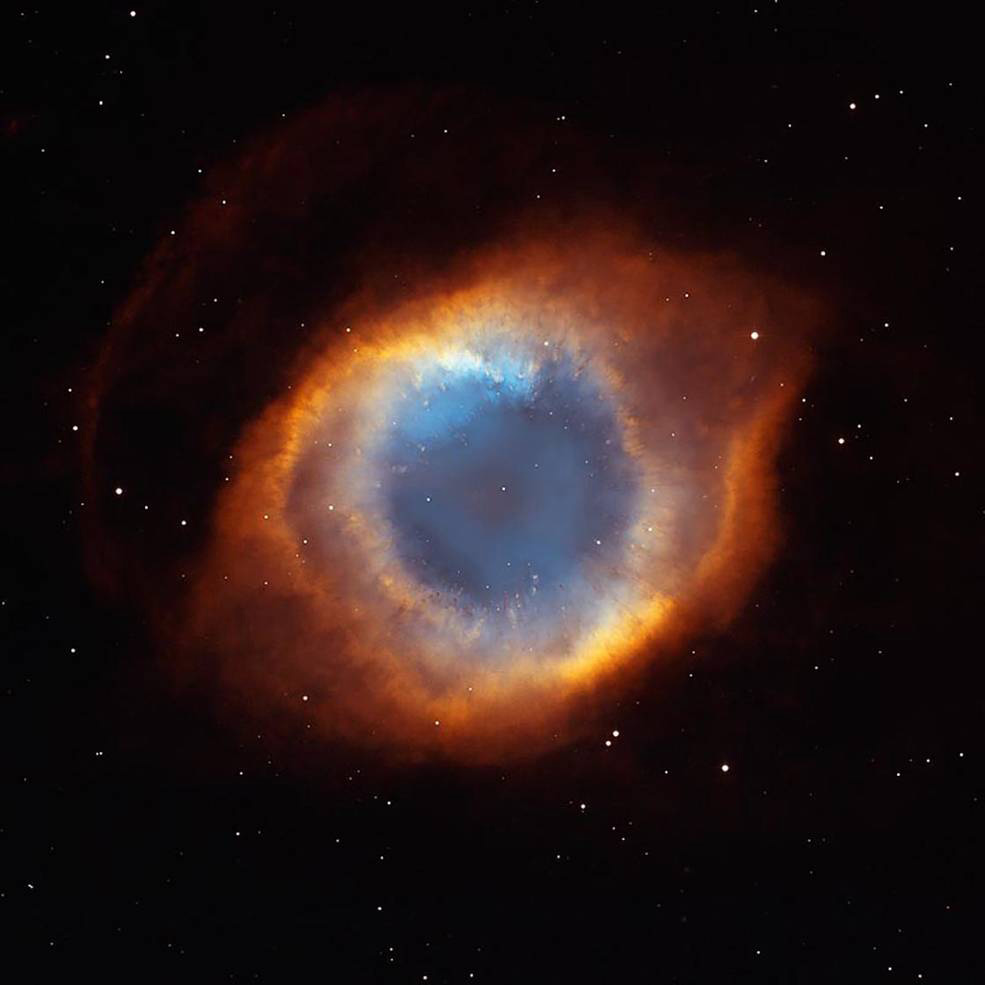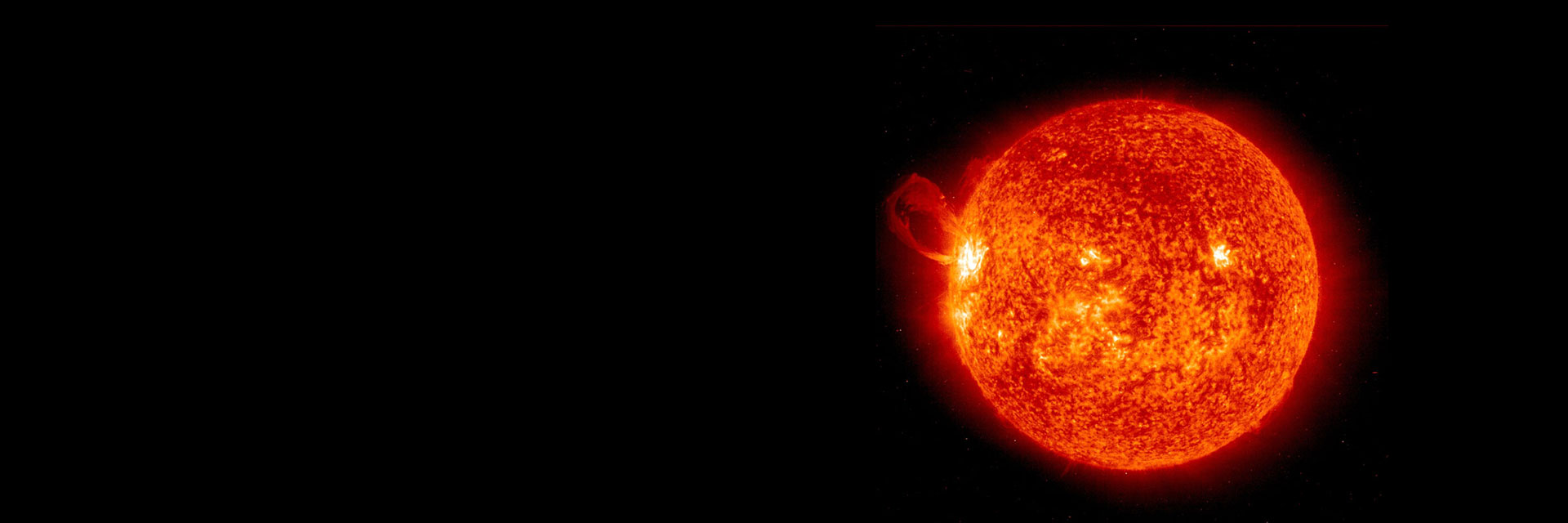Expanded from question three of the big three heliophysicist investigative questions: What causes the Sun to vary? Learn more ›
The Sun goes through both short-term and long- term cycles. In the short term, every 11 years or so, the Sun's magnetic field completely flips. This is called the solar cycle. During solar maximum, when the magnetic fields are the most unstable, solar activity increases, intensifying the solar wind, causing space weather. Solar maximum can easily be observed by counting the number of sunspots. In the long term (billions of years), the Sun, like all stars, has a life cycle. Near the end of its nuclear burning stage, the star expels most of its outer material until only the hot core remains, which then settles down to become a white dwarf. That expelled outer material, primarily made of gas, is called a planetary nebula, which drifts through space, and one day, could become part of a new star, beginning the cycle again.

Best Practice! Using Guiding Questions to Drive Inquiry
Each big idea has student-friendly questions written at different levels that you can use to guide inquiry-based investigations at the appropriate level. Explore this big idea at each level below, with featured resources you can engage learners with.
Introductory Learner
Guiding Question: How was the Sun born?
Standards: ESS1, LS1, ESS1
Heliophysics Narrative:
- Like the life cycles of plants and animals, and even rocks, all stars, including the Sun, have a life cycle. The Sun was born 4.7 billion years ago, made from a stellar nebula, which is basically a star nursery. This is a great place for stars to be born because there is lots of dust and gas and all the things needed to make a planetary system. But just like the cycles on Earth, where matter is recycled over and over again (e.g. a dead animal decomposes and provides nutrients to a growing tree) stars die and provide material for the birth of new stars.
- At this level, students know the Sun is a star (5-ESS1-1) and are exploring the life cycles of organisms on Earth (3-LS1-1). Students can understand that events (on Earth and in space) can happen on a longer time scale, too long for humans to observe (2-ESS1-1), which will help students better comprehend the time scale relating to the lives of stars. In grade 4, students continue to explore bigger time scales when they examine rock formations on Earth (4-ESS1-1).
- Connect to the Sun by emphasizing that the Sun formed about 4.7 billion years ago in a giant, spinning cloud of gas and dust called a nebula. A nebula is where stars are born. Over time, gravity brings all of that gas and dust in the nebula together, where it heats up, and starts to spin. The material spins faster and faster until it is flattened into a pancake-like disk. Most of that material became our Sun, at the center, and the extra material formed the planets around it.
- Extend student exploration by investigating space dust. Is space very dusty? Space is dusty because ancient stars become so cool that dust grains can condense out of the star's outer layers, like rain condensing out of clouds on Earth. These dust grains are then driven out into space and become part of stellar nurseries.
- Support younger students by thinking about how you can't make something from nothing, which is why we see cycles on Earth and in the universe.
- Challenge students at the next level by having them investigate how the Sun will end its life.
Featured Resource: Star Formation: Eagle Nebula ›
Intermediate Learner
Guiding Question: What is the life cycle of stars?
Standards: ESS1
Heliophysics Narrative:
- Stars have a life cycle, much like the other cycles you have observed here on Earth. The Sun, like other stars, was born in a stellar nebulae, made of dust and gas. Stars live out most of their lives as stable stars, burning hydrogen into helium and producing energy. When stars run out of fuel they end their lives in different ways, depending on the mass of the star. The Sun will end its life as a dim, cool object called a white dwarf. More massive stars end their lives as supernovae. While supernovae can produce a black hole, the Sun will never become a black hole. It simply is too small.
- At this level, students learn how the solar system formed by and model time in the geological time scale (MS-ESS1-2,4.).
- Connect to the Sun by reviewing how the evolution of the Sun has affected Earth in the past and will affect Earth in the future. When the Sun and Earth formed, the Sun was 30% dimmer than it is today. Earth should have been a frozen snowball at the time when life was first beginning, but because of Earth’s dense greenhouse atmosphere, Earth’s temperature remained above the freezing point of water. As the Sun has evolved to the present time as a main-sequence star, its solar output has steadily increased and will continue to do so over the next 5 billion years. 2 billion years from now, the oceans will start to evaporate, which will be the end of organic life on the surface of Earth. 5 billion years from now, the Sun will become a red giant and engulf the inner solar system, and Earth will be gone. And from that point on, the core of the Sun will cool to a white dwarf and eventually fade away.
- Extend student exploration by investigating the life cycle of more massive stars.
- Support beginner students by reviewing the time scales related to the formation of the solar system.
- Challenge students at the next level by investigating nuclear processes on Earth and how they compare to the nuclear processes in stars. Making this amount of energy on Earth is very challenging. Nuclear fusion reactions only last a matter of minutes on Earth.
Featured Resource: Life and Death of Planetary System ›
Advanced Learner
Guiding Question: Do other stars behave similarly to the Sun?
Standards: PS1, ESS1
Heliophysics Narrative:
- Other stars behave similarly to our Sun in their formation, lifespan, and nuclear processes. Stars vary in mass, composition, color, brightness, and age. These variables determine the lifespan of the star. Larger mass stars have short, violent lifespans, while our medium-sized Sun is living a long, stable life. We are halfway through the Sun's lifespan, which has given Earth enough time to evolve life. Like other stars, the Sun will eventually deplete its fuel and its life will end.
- At this level, students learn about nuclear processes in the Sun, the influence of the Sun on Earth (HS-ESS1-1) (HS-ESS1-8), and how we study other stars (HS-ESS1-2,3).
- Connect to the Sun seamlessly through this question. Emphasize that life on Earth exists because of the Sun, and that we don't know of any other stars in the galaxy that host planets with life. The Sun is the right size, the right age, and Earth is the perfect distance from the Sun. More massive stars have shorter life spans and also produce intense amounts of UV light, which is damaging to living organisms.
- Extend student exploration by investigating other factors that contribute to Earth's success. Jupiter's gravity may help deflect asteroids on a collision course with Earth, and scientists believe that the Moon (a result of a collision of an object with Earth) helps stabilize Earth's rotation, keeping our climate stable. It is the combination of all of these factors that makes Earth unique in the known universe.
- Support beginner students by reviewing the structure of the Sun and the nuclear processes at its core.
- Challenge students at the next level to investigate how NASA studies distant stars, using the knowledge we have gained from studying our own Sun.
Featured Resource: Lives of Stars Infographic ›
What level are my learners?
Introductory: A younger learner (K-5), or a learner new to the subject matter.
Intermediate: A middle-aged learner (6-8), or a learner that has some familiarity with the subject matter.
Advanced: An older learner (9-12+), or a learner that has a lot of experience with the subject matter.
Note: Next Generation Science Standards (K-12) are mapped to the resources accordingly.
What is a NGSS Heliophysics Narrative?
NGSS Heliophysics Narratives support educators with the incorporation of heliophysics concepts and resources into their existing curricula. The narratives consist of relevant heliophysics background information, applicable NGSS performance expectations, and guiding questions to spark inquiry-based learning at the appropriate level.
Narrative Structure:
- Short answer to the question, for teacher background knowledge
- An analysis of NGSS Performance Expectations (PE) to determine learning constraints at each level
- Heliophysics topics that connect to the NGSS PE and can be infused into teaching systems science
- More heliophysics to explore
- How to support beginner learners
- How to challenge learners at the next level





